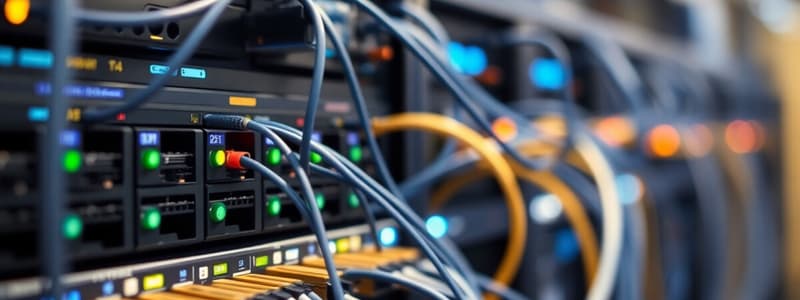Podcast
Questions and Answers
A wide area network (WAN) spans a large physical distance.
A wide area network (WAN) spans a large physical distance.
True (A)
In a peer-to-peer network, clients communicate only through a central server.
In a peer-to-peer network, clients communicate only through a central server.
False (B)
Ethernet is developed by the Institute of Electrical and Electronics Engineers (IEEE).
Ethernet is developed by the Institute of Electrical and Electronics Engineers (IEEE).
True (A)
Backward compatibility allows current devices to only use the most recent networking standards.
Backward compatibility allows current devices to only use the most recent networking standards.
Wired networks cannot use fiber-optic cables for data transmission.
Wired networks cannot use fiber-optic cables for data transmission.
A broadband connection requires a modem.
A broadband connection requires a modem.
In client/server networks, nodes communicate directly with each other.
In client/server networks, nodes communicate directly with each other.
Packets are the bundles of data sent across a network.
Packets are the bundles of data sent across a network.
Network navigation devices include only routers.
Network navigation devices include only routers.
One main reason for setting up a network is to share an Internet connection.
One main reason for setting up a network is to share an Internet connection.
A computer network consists of two or more computers connected via software and hardware to communicate.
A computer network consists of two or more computers connected via software and hardware to communicate.
A node in a network refers only to computers.
A node in a network refers only to computers.
The major downside of networks is the potential for faster internet speeds.
The major downside of networks is the potential for faster internet speeds.
Bandwidth refers to the actual speed at which data is transferred.
Bandwidth refers to the actual speed at which data is transferred.
A local area network (LAN) connects devices over a small geographical area.
A local area network (LAN) connects devices over a small geographical area.
A personal area network (PAN) supports devices that are far apart from one another.
A personal area network (PAN) supports devices that are far apart from one another.
Common benefits of networking include sharing files and Internet connections.
Common benefits of networking include sharing files and Internet connections.
Throughput and data transfer rate are typically expressed in bytes per second.
Throughput and data transfer rate are typically expressed in bytes per second.
A metropolitan area network (MAN) is designed for small local areas, like a home.
A metropolitan area network (MAN) is designed for small local areas, like a home.
Wireless networks can be secured to prevent unauthorized access.
Wireless networks can be secured to prevent unauthorized access.
Broadband is often referred to as high-speed Internet.
Broadband is often referred to as high-speed Internet.
Satellite Internet is primarily used in urban areas.
Satellite Internet is primarily used in urban areas.
Dial-up access is the fastest way to connect to the Internet.
Dial-up access is the fastest way to connect to the Internet.
A data plan is known as an Internet connectivity plan.
A data plan is known as an Internet connectivity plan.
A network switch acts like a traffic signal on a network.
A network switch acts like a traffic signal on a network.
Wi-Fi 4 or Wi-Fi 5 devices have a maximum range of about 500 feet.
Wi-Fi 4 or Wi-Fi 5 devices have a maximum range of about 500 feet.
Ethernet standards do not affect the efficiency of a home network.
Ethernet standards do not affect the efficiency of a home network.
Network-attached storage (NAS) devices are used to store and manage network data.
Network-attached storage (NAS) devices are used to store and manage network data.
Apple routers are only compatible with Apple computers.
Apple routers are only compatible with Apple computers.
Walls and floors have no effect on wireless signal strength.
Walls and floors have no effect on wireless signal strength.
Flashcards
Computer Network
Computer Network
Two or more computers connected via software and hardware for communication.
Node
Node
Any device connected to a network (computer, printer, router).
Data Transfer Rate
Data Transfer Rate
The maximum speed data can be transmitted on a network.
Throughput
Throughput
Signup and view all the flashcards
LAN
LAN
Signup and view all the flashcards
HAN
HAN
Signup and view all the flashcards
PAN
PAN
Signup and view all the flashcards
Network Benefits
Network Benefits
Signup and view all the flashcards
Network Drawbacks
Network Drawbacks
Signup and view all the flashcards
Mbps/Gbps
Mbps/Gbps
Signup and view all the flashcards
WAN
WAN
Signup and view all the flashcards
Client/Server Network
Client/Server Network
Signup and view all the flashcards
Peer-to-Peer (P2P) Network
Peer-to-Peer (P2P) Network
Signup and view all the flashcards
Network Protocols (Ethernet)
Network Protocols (Ethernet)
Signup and view all the flashcards
Backward Compatibility
Backward Compatibility
Signup and view all the flashcards
Network Nodes
Network Nodes
Signup and view all the flashcards
Network Adapter
Network Adapter
Signup and view all the flashcards
Network Interface Card (NIC)
Network Interface Card (NIC)
Signup and view all the flashcards
Network Transmission Media
Network Transmission Media
Signup and view all the flashcards
Network Operating System (NOS)
Network Operating System (NOS)
Signup and view all the flashcards
Broadband Internet
Broadband Internet
Signup and view all the flashcards
Internet Service Provider (ISP)
Internet Service Provider (ISP)
Signup and view all the flashcards
WiFi Router
WiFi Router
Signup and view all the flashcards
Mobile Hotspot
Mobile Hotspot
Signup and view all the flashcards
Network-attached storage (NAS)
Network-attached storage (NAS)
Signup and view all the flashcards
Ethernet Standard
Ethernet Standard
Signup and view all the flashcards
Data Plan
Data Plan
Signup and view all the flashcards
Wi-Fi Interference
Wi-Fi Interference
Signup and view all the flashcards
Network Node
Network Node
Signup and view all the flashcards
Wireless Range
Wireless Range
Signup and view all the flashcards
Study Notes
Chapter 7: Networking: Connecting Computing Devices
- This chapter focuses on computer networks, their benefits, drawbacks, types, components, and security.
- Learning objectives include describing computer networks, explaining network definitions, describing transmission media, identifying hardware components, describing software needs, and summarizing Internet access options.
- Additional objectives include wireless internet access, planning a home network, connecting devices to a network, troubleshooting wireless issues, and managing wireless networks.
Networking Fundamentals
- A computer network connects two or more computers enabling communication.
- Each device on a network is a node—this can be a computer, peripheral, or network device.
- Benefits of networks include sharing high-speed internet, printers, peripherals, files, and communication.
- The major disadvantage of networks is the time needed for setup and administration.
- Data transfer rate (bandwidth) is the maximum data transmission speed.
- Throughput is the actual data transfer speed.
Network Architectures
- Network classification by distance:
- Personal area network (PAN): Communication among devices near a person.
- Local area network (LAN): Network in a small geographical area.
- Home area network (HAN): A specific type of LAN located at home.
- Metropolitan area network (MAN): A large network covering a city.
- Wide area network (WAN): Network spanning a large physical distance.
- Network classification by administration levels:
- Client/server network: Clients request information from a central server.
- Peer-to-peer (P2P) network: Each node can directly communicate with every other node.
- Network classification by protocols:
- Ethernet: Developed by IEEE, used in both wired and wireless networks (Wi-Fi, Gigabit Ethernet (GbE)).
- Backward compatibility: Ability of devices to use older standards in addition to the current standard.
Network Components
- Networks require transmission media(cables or wireless technology) for connection, special hardware for communication, and software to run them.
- Network components (hardware) include network adapter (NIC), modem, router, switch.
- A network adapter is an integrated device (NIC) essential to each network node.
- A modem translates signals for broadband connections.
- A router transfers data packets between networks.
- A switch controls data flow within a network.
Network Components: Software
- Networks need operating system software for P2P networks and specialized network operating system (NOS) software for client/server networks to manage communication through a central server.
Connecting to the Internet: Broadband
- The primary reason for networking is sharing internet connections.
- Internet service providers (ISPs) provide internet access to individuals and businesses.
- Broadband internet options include cable, DSL, and fiber optic.
- Other internet access methods such as cellular and dial-up are also available.
Connecting to the Internet: Wireless
- Wireless internet access options include mobile broadband, wireless internet at home, mobile hotspot, wireless ISP, and data plans.
Installing and Configuring Home Networks
- Planning a home network includes: listing equipment, using the latest Ethernet standards, using newer equipment for improved speed.
- Network devices for connecting devices into a network include routers and switches.
- Specialized home network devices include network attached storage (NAS) devices and home network servers to store and share files in networks.
Troubleshooting Wireless Networks
- Important considerations when troubleshooting wireless network problems include the maximum Wi-Fi range, common interference sources such as walls and metal, and using wireless range extenders to boost signal strength.
Managing and Securing Wireless Networks
- Proper security measures for wireless networks involves using security protocols, changing the network name (SSID), disabling SSID broadcast, changing default password, and creating complex passphrases.
- Additional security measures include implementing Media Access Control (MAC), limiting signal range, keeping router firmware up-to-date, and disabling remote access.
Studying That Suits You
Use AI to generate personalized quizzes and flashcards to suit your learning preferences.




